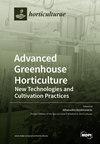‘Rootpac R’ for Apricots? Yes!
IF 3.1
3区 农林科学
Q1 HORTICULTURE
引用次数: 0
Abstract
The rootstock ‘Rootpac R’ is not used for apricots. The aim of this study was to evaluate the characteristics of ‘Rootpac R’ in comparison to the widely used ‘Myrobalan 29C’ rootstock. The evaluation of the rootstocks was conducted in combination with 16 scion cultivars to assess their effects on vegetative traits and mortality. The total height of the trees on ‘Rootpac R’ initially surpassed the ‘Myrobalan 29C’ trees. By the end of the fourth year, both rootstocks showed comparable heights with ‘Rootpac R’ standing at 317 cm and ‘Myrobalan 29C’ standing at 307 cm. Both rootstocks exhibited comparable TCSA values of 5 cm2 initially; ‘Rootpac R’ surpassed 35% compared to ‘Myrobalan 29C’. Canopy space occupancy assessments revealed that ‘Rootpac R’ initially demonstrated superior space utilization, occupying 8% of the designated volume compared to 4% for ‘Myrobalan 29C’. By the fourth year, ‘Rootpac R’ exhibited a higher occupancy rate of 65% compared to 50% for ‘Myrobalan 29C’. For apricot cultivars, such as ‘Bergeron’, ‘C. óriás’, ‘Gönci magyarkajszi’, ‘Lady Cot’, ‘Tardif de Valance’, and ‘Tom Cot’, ‘Rootpac R’ exhibited survival rates beyond the fourth season, highlighting its effectiveness for these varieties. Based on these results, ‘Rootpac R’ rootstock could be useful in apricot growing.杏树的'Rootpac R'?是的!
Rootpac R "砧木未用于杏树。本研究的目的是评估'Rootpac R'与广泛使用的'Myrobalan 29C'砧木的特性。对砧木的评估是结合 16 个接穗栽培品种进行的,以评估它们对无性系特征和死亡率的影响。使用'Rootpac R'的树木总高度最初超过了'Myrobalan 29C'。到第四年年底,两种砧木的高度相当,'Rootpac R'为317厘米,'Myrobalan 29C'为307厘米。两种砧木最初的 TCSA 值均为 5 cm2;'Rootpac R'比'Myrobalan 29C' 高出 35%。树冠空间占用评估显示,"Rootpac R "最初的空间利用率较高,占指定体积的 8%,而 "Myrobalan 29C "仅占 4%。到第四年,'Rootpac R'的占用率达到 65%,而'Myrobalan 29C'的占用率为 50%。对于杏栽培品种,如'Bergeron'、'C. óriás'、'Gönci magyarkajszi'、'Lady Cot'、'Tardif de Valance'和'Tom Cot','Rootpac R'的存活率超过了第四季,突出表明了它对这些品种的有效性。基于这些结果,'Rootpac R'砧木在杏树种植中是有用的。
本文章由计算机程序翻译,如有差异,请以英文原文为准。
求助全文
约1分钟内获得全文
求助全文

 求助内容:
求助内容: 应助结果提醒方式:
应助结果提醒方式:


